Description
Several species of wireworms, all quite similar in appearance,
attack the roots of many crops. The name wireworm aptly describes
these insects (Fig. 1). When young they are cream colored, about
1/4 inch long, and less than 1/16 inch in diameter; when mature
they are 1 1/4 to 1 1/2 inches long and about 1/8 inch in diameter.
The pupal stage is free, the entire structure of the adult's
body being apparent. The adult is a click beetle (Fig. 4). When
placed on its back, it flips into the air with an audible snap
and lands on its feet. The eggs are tiny, white globules found
in the soil. |
Click
on image for larger version
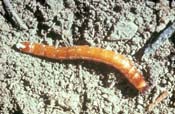
Figure
1. Wireworm Larva
|
Life
History
The winter is spent as a larva or beetle in the soil. In the spring
the adults become active, fly about, feed, and lay their eggs. Adults
may live for as long as 12 months. The larva may live for two to
six years in the soil, feeding on roots of weeds, grasses, and other
crops. The pupal stage is short, perhaps two weeks, and is spent
in a cell in the soil. With this long a life cycle, one generation
may require six or seven years for completion.The winter is spent
as a larva or beetle in the soil. In the spring the adults become
active, fly about, feed, and lay their eggs. Adults may live for
as long as 12 months. The larva may live for two to six years in
the soil, feeding on roots of weeds, grasses, and other crops. The
pupal stage is short, perhaps two weeks, and is spent in a cell
in the soil. With this long a life cycle, one generation may require
six or seven years for completion.
|
Click
on image for larger version
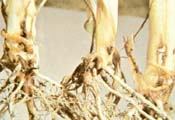
Figure
2. Wireworm Damage to Corn
|
Damage
In root crops, like potatoes, wireworms drill into the actual
tubers. In other crops, they drill holes in the underground
portion of the stalk and may even destroy the seeds before germination.
In corn specifically, the worms hollow out the seed, preventing
germination. If they do not attack the seed, they drill a hole
in the stalk and sometimes all the way through it. The stalks
of small seedlings may be hollowed out up to and even above
the soil surface. |
First
evidence of wireworm damage to corn stands is lack of germination.
The wireworm eats out the seed germ, and only a few plants will
appear in a large area. If the seeds do germinate, the worm attacks
the small seedlings, which usually wilt and die, adding to the spotted
appearance of the stand. They then attack the plants that escape,
causing the center leaves of these larger plants to wilt. If the
larger plants do not die, they are severely stunted or grow in a
distorted fashion. A new shoot will emerge from the hole in the
plant below the soil surface. These distorted plants may live but
will not produce an ear.
| Damage
may continue for some time, and plants will still be wilting
when they are more than knee-high. Damage occurs primarily in
the spring during cool, moist weather. As soil temperatures
rise and soil moisture decreases,the wireworms migrate deeper
into the soil to find cooler temperatures and moisture. Thus,
little damage occurs after June. However, one exception is peat
soil, in which wireworms may be a serious problem all season
long. |
Wireworm
Bait Station
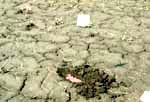
Click on image to see video
|
Wireworms
are usually most damaging in bottom lands or poorly drained areas
on upland soils. Water spots in the field often have the heaviest
populations. In some years of general wireworm damage, there seems
to be a relationship between crops that were in the field two years
before corn is damaged. Small grains, especially wheat, are the
most suspected crop.
|
Click
on image for larger version
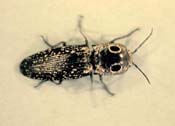
Figure
3. Wireworm Adult
|
Click
on image for larger version
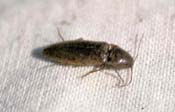
Figure
4. Wireworm Adult
|
Authors:
Susan T. Ratcliffe (sratclif@uiuc.edu)
Michael E. Gray (m-gray4@uiuc.edu)
Kevin L. Steffey (ksteffey@uiuc.edu)
|



